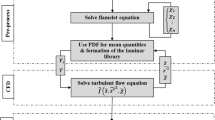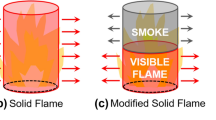Abstract
A pool fire characterized by high temperature and heat radiation, is a common accident in chemical industry. The important combustion characteristic parameters are the heat radiation flux, the burning rate, the flame height, etc., but the most significant one is the heat radiation flux. The calculation model of the pool fire has an important role to assess the accident. There are three types of widely used pool fire models, the Shokri and Beyler model, the Mudan model, and the point source model. The models are used to calculate the combustion parameters of three different kinds of oils in tanks of different scales. The predictions of three models are compared with the simulation results. The analysis shows that the point source model has a large error for pool fires with the diameter greater than 10 m and the thermal radiation flux smaller than 5 kW/m2, and the model is more applicable to heavy crude pool fires. The scope of application of the Mudan model is broader, and this model ensures higher accuracy if the thermal radiation flux is smaller than 5 kW/m2. The Shokri and Beyler model is more suitable for the case where the pool fire diameter is greater than 40 m and the thermal radiation flux is above 5 kW/m2, and the results for the light crude pool fire based on this model are more reasonable.
Similar content being viewed by others
References
Zhi-rong Wang, Jun-cheng Jiang, and Hui Jiang, “Review of Characteristic Environment of Outdoor Pool Fire,” Chem. Eng. Oil Gas 34(4), 321–324 (2005).
A. Hamins, “Flame Extinction by Sodium Bicarbonate Powder in a Cup Burner,” Proc. Combust. Inst. 27(2), 2857–2864 (1998).
E. Planas-Cuchi and J. Casal, “Flame Tempreture Distribution in a Poll-Fire,” J. Hazard. Mater. 62(3), 231–241 (1998).
Hiroshi Koseki, Yusaku Iwata, Toru Takahashi, et al., “Large-Scale Boilover Experiments using Crude Oil,” Fire Saf. J. 41(7), 529–535 (2006).
Liu Bo, Liang Dong, and Huang Yanbo, “Heat Radiation Calculation and Simulation of Pool Fire,” Saf. Health Environ. 9(1), 36–38 (2009).
Zhi-min Fu, Jin-yin Huang, Min Fu, et al., “Quantitative Analysis of Damaging Effect of Hydrocarbon Fluid Fire,” China Saf. Sci. J., No. 9, 29–36 (2008).
R. D. Peacock and V. Babrauskas, “Analysis of Large-Scale Pool Fire Test Data,” Fire Saf. J. 17(5), 387–414 (1991).
De-ming Yu, Chang-gen Feng, Qing-xuan Zeng, et al., “Pool Fire in Open Air and the Hazard Analysis,” Combust. Sci. Technol. 2(2), 95–103 (1996).
M. Hertzberg, C. D. Litton, W. F. Donaldson, and D. Burgess, “The Infrared Radiance and the Optical of Fires and Explosins,” Proc. Combust. Inst. 15(1), 137–144 (1975).
A. Hamins, E. Johnsson, M. Donnelly, et al., “Energy Balance in Large Compartment Fire,” Fire Saf. J. 43,(3), 180–188 (2008).
V. Babrauskas, “Smoke and Gas Evolution Rate Measurements on Fire-Retarded Plastics with the Cone Calorimeter,” Fire Saf. J. 14(3), 135–142 (1989).
P. J. Rew, H. Spencer, and J. Daycock, “Off-Side Ignition Probability of Flammable Gases,” J. Hazard. Mater. 71(1–3), 409–422 (2000).
Chao Hu, Guo-qing Zhu, and Wei-hua Wu, “The Model Calculation and Analysis of the Pool Fire Hazards,” Fire Sci. Technol. 33(30), 570–573 (2011).
P. A. Croce and K. S. Mudan, “Calculating Impacts for Large Open Hydrocarbon Fires,” Fire Saf. A J. 11(1/2), 99–112 (1986).
V. Babrauskas, “A Simplified Characterization of Upholstered Furniture Heat Release Rates,” Fire Saf. J. 11(3), 181–192 (1986).
K. S. Mudan, “Geometric View fa Ctors for Thermal Radiation Hazard Assessment,” Fire Saf. J. 12(2), 89–96 (1987).
C. G. Soares and A. P. Teixeira, “Probabilistic Modeling of Off ShoreFfires,” Fire Saf. J. 34(1), 25–45 (2000).
E. Planas-Cuchi and J. Casal, “Modeling Temperature Evolution in Equipment Engulfed in a Pool-Fire,” Fire Saf. J. 30(3), 251–268 (2000).
Atsushi Nakakuki, “Heat Transfer in Hot-Zone-Forming Pool Fires,” Combust. Flame 109(3), 353–369 (1997)
Xiao Ze-nan, Xie Da-yong, and Sun Xuan, “The Application of CFD Technique used in Modeling Smoke Movement in Large Space,” Fire Sci. Technol. 24(2), 175–178 (2005).
D. Madrzykowski and R. L. Verrori, Simultaion of the Dynamics of the Fierta 3l44 Cherry Road NE (National Institute of Standards and Technology Gaithersburg, MD20899, 2000).
Y. L. Sinai, “Exploratory CFD Modeling of Pool Fire Instabilities without Cross-Wind,” Fire Saf. J. 35(1), 51–61 (2000).
Yang Jun-tao, Wei Dong, Zhang Xue-kui, et al., “The Theoretical Analysis of the Burning Characteristics for Oil Tank Fires,” J. Eng. Thermophys. 27(1), 151–154 (2006).
Wei Dong, Zhao Da-lin, Du Yu-long, et al., “Experimental Study on the Burning Rate of Oil Tank Fires,” J. Combust. Sci. Technol. 11(31), 286–291 (2005).
Author information
Authors and Affiliations
Corresponding author
Additional information
Original Russian Text © Zh. Chen, X.-N. Wu, W.-H. Song, L.-Yu. Lv, X.-D. Wang.
__________
Translated from Fizika Goreniya i Vzryva, Vol. 50, No. 3, pp. 51–60, May–June, 2014.
Rights and permissions
About this article
Cite this article
Chen, Z., Wu, X.N., Song, W.H. et al. Applicability analysis of mathematical models for the combustion characteristics in the pool fire. Combust Explos Shock Waves 50, 290–299 (2014). https://doi.org/10.1134/S001050821403006X
Received:
Revised:
Published:
Issue Date:
DOI: https://doi.org/10.1134/S001050821403006X




